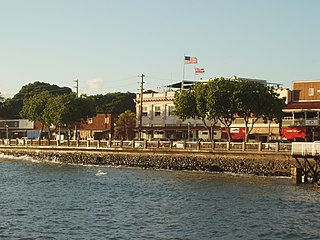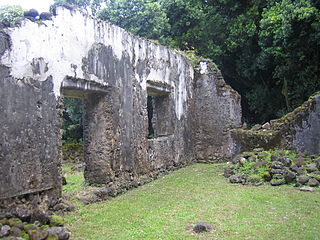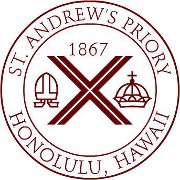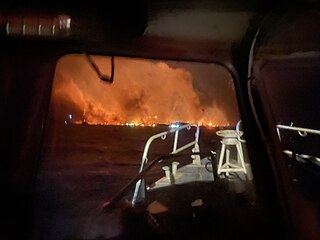
Lahaina is a census-designated place (CDP) in Maui County, Hawaii, United States. On the northwest coast of the island of Maui, it encompasses Lahaina town and the Kaanapali and Kapalua beach resorts. As of the 2020 census, Lahaina had a resident population of 12,702. The CDP spans the coast along Hawaii Route 30 from a tunnel at the south end, through Olowalu, and to the CDPs of Kaanapali and Napili-Honokowai to the north.

Bernice Pauahi Pākī Bishop KGCOK RoK was an aliʻi (noble) of the royal family of the Kingdom of Hawaii and a well known philanthropist. At her death, her estate was the largest private landownership in the Hawaiian Islands, comprising approximately 9% of Hawaii's total area. The revenues from these lands are used to operate the Kamehameha Schools, which were established in 1887 according to Pauahi's will. Pauahi was married to businessman and philanthropist Charles Reed Bishop.

Kamehameha Schools, formerly called Kamehameha Schools Bishop Estate (KSBE), is a private school system in Hawaiʻi established by the Bernice Pauahi Bishop Estate, under the terms of the will of Princess Bernice Pauahi Bishop, who was a formal member of the House of Kamehameha. Bishop's will established a trust called the "Bernice Pauahi Bishop Estate" that is Hawaiʻi's largest private landowner. Originally established in 1887 as an all-boys school for native Hawaiian children, it shared its grounds with the Bishop Museum. After it moved to another location, the museum took over two school halls. Kamehameha Schools opened its girls' school in 1894. It became coeducational in 1965. The 600-acre (2.4 km2) Kapālama campus opened in 1931, while the Maui and Hawaiʻi campuses opened in 1996 and 2001, respectively.

The Bernice Pauahi Bishop Museum, designated the Hawaiʻi State Museum of Natural and Cultural History, is a museum of history and science in the historic Kalihi district of Honolulu on the Hawaiian island of Oʻahu. Founded in 1889, it is the largest museum in Hawaiʻi and has the world's largest collection of Polynesian cultural artifacts and natural history specimens. Besides the comprehensive exhibits of Hawaiian cultural material, the museum's total holding of natural history specimens exceeds 24 million, of which the entomological collection alone represents more than 13.5 million specimens. The Index Herbariorum code assigned to Herbarium Pacificum of this museum is BISH and this abbreviation is used when citing housed herbarium specimens.

The Ala Moana Center, commonly known simply as Ala Moana, is a large open-air shopping mall in the Ala Moana neighborhood of Honolulu, Hawaii. Owned by Brookfield Properties, Ala Moana is the eighth largest shopping mall in the United States and the largest open-air shopping center in the world.

Mauna ʻAla in the Hawaiian language, is the Royal Mausoleum of Hawaii and the final resting place of Hawaii's two prominent royal families: the Kamehameha Dynasty and the Kalākaua Dynasty.

Maria Lanakila Catholic Church is a parish of the Catholic Church of Hawaii in the United States. Located in Lahaina on the island of Maui, the church falls under the jurisdiction of the Diocese of Honolulu and its bishop. The parish has a mission in Kapalua under the title of the Sacred Hearts of Jesus and Mary. Maria Lanakila means "Victorious Mary", the Hawaiian language equivalent to the English language epithet "Our Lady of Victory", which refers to the Blessed Virgin Mary.

Kaniakapūpū, known formerly as Luakaha, is the ruins of the former summer palace of King Kamehameha III and Queen Kalama on the island of Oahu in Hawaii. Built in the 1840s, and situated in the cool uplands of the Nuʻuanu Valley, it served as the king and queen's summer retreat after the capital of the Kingdom of Hawaii moved from Lahaina to Honolulu in 1845. It was famous for being the site of a grand luau attended by an estimated ten thousand guests during the 1847 Hawaiian Sovereignty Restoration Day celebration. The palace had fallen into ruins by 1874; no records exist about its condition in the intervening years. Rediscovered in the 1950s, the site was cleared and efforts were made to stabilize the ruins from further damage by the elements and invasive plant growth. The site remains officially off-limits to the public and trespassers are subjected to citations, although the site is not regularly monitored.
Hawaii Superferry was a Hawaii-based transportation company that provided passenger and vehicle transportation between Honolulu Harbor on the island of Oʻahu and Kahului Harbor on Maui. Legal issues over environmental impact statements and protests from residents of Maui and Kauaʻi temporarily delayed the implementation of service, but service between Oʻahu and Maui began in December 2007. The company had hoped to return service to Nawiliwili Harbor on Kauaʻi and additionally planned to eventually provide service to Kawaihae Harbor on the Big Island.

The Wo Hing Society Hall was a building located at 858 Front Street in the Lahaina Historic District in Lahaina, Hawaii. Built around 1912, it served the growing Chinese population centered in Lahaina, primarily those working in the sugarcane industry as a social and fraternal hall for the Wo Hing Society. By the 1940s the declining Chinese population in Lahaina slowly made the building redundant and the property was neglected.
At their peak, there were six Chinese Society Halls on Maui. Operated by the Gee Kung Tong Society, these halls were created to provide services to immigrant Chinese workers, mostly working for the sugarcane plantations. All provided religious and political help, in addition to mutual aid. Only the Wo Hing Society Hall in Lahaina and the Ket Hing Society Hall in Kula have survived. Both were placed on the Hawaii State Register of Historic Places on July 30, 1982, and placed on the National Register of Historic Places on November 15, 1982. The Chee Kung Tong Society Hall was placed onto both State and Federal registers, but collapsed in 1996.

Lahaina Historic District is a National Historic Landmark District encompassing most of the community of Lahaina, Hawaii, on the west side of the island of Maui in the US state of Hawaii. Designated in 1962, the district recognizes Lahaina for its well-preserved character as a 19th-century port, and for its social and economic importance in the 19th century as a major whaling center in the Pacific, and as one of the capital cities of the Kingdom of Hawaii.

Lucy Kaopaulu Peabody was a high chiefess and courtier of the Kingdom of Hawaii. She served as a maid of honour and lady-in-waiting to Queen Emma of Hawaii. In 1905, she founded the reestablished Kaʻahumanu Society, a female-led civic society initially chartered during the Hawaiian monarchy.

St. Andrew's Schools is a private K–12 school in Honolulu, Hawaii. Made up of The Priory, an all-girls K–12 program with a college preparatory school; The Prep, the all-boys K–5 program; and a co-educational preschool for ages 2–5 years in the Nu'uanu valley. Founded in 1867 by Queen Emma Kaleleonālani, wife of King Kamehameha IV, the schools enroll students in preschool through grade 12 year round. The enrollment is about 550, with a student-teacher ratio of 8 to 1. Today, the school is affiliated with the Episcopal Church. It is administered by a board of trustees and is the oldest all-girls school in Hawai'i. More than half the faculty have advanced degrees, and virtually 100% of graduates attend four-year colleges and universities across the country.

Dwight Baldwin was an American Christian missionary and medical doctor on Maui, one of the Hawaiian Islands, during the Kingdom of Hawaii. He was patriarch of a family that founded some of the largest businesses in the islands.

Waiola Church and Cemetery in Lāhainā is the site of a historic mission established in 1823 on the island of Maui in Hawaiʻi. Originally called Waineʻe Church until 1953, the cemetery is the final resting place for early members of the royal family of the Kingdom of Hawaii.

Lahaina Banyan Court Park is a public park in the town of Lahaina, Hawaii, The 1.94 acres (0.79 ha) park, also known as Lahaina Courthouse Square and commonly called Banyan Tree Park, contains multiple heritage sites. Located at the corner of Front Street and Canal Street, it is part of the Lahaina Historic Districts.

Paul Nahaolelua was a Hawaiian high chief who served many political posts in the Kingdom of Hawaii, including Governor of Maui from 1852 to 1874. In his long political career, Nahaolelua served under the reigns of five monarchs: Kamehameha III, Kamehameha IV and Kamehameha V, Lunalilo and Kalākaua.
Mary Lambert Jones Dominis was an American settler of Hawaii and the first mistress of Washington Place in Honolulu. Born into a large New England family, she married merchant sea Captain John Dominis, for whom Honolulu was a frequent port of trade. The couple relocated in 1837 to the Hawaiian Kingdom with their son John Owen Dominis. Their two daughters remained behind to complete their education.

In early August 2023, a series of wildfires broke out in the U.S. state of Hawaii, predominantly on the island of Maui. The wind-driven fires prompted evacuations and caused widespread damage, killing at least 101 people and leaving two persons missing in the town of Lahaina on Maui's northwest coast. The proliferation of the wildfires was attributed to dry, gusty conditions created by a strong high-pressure area north of Hawaii and Hurricane Dora to the south.
























